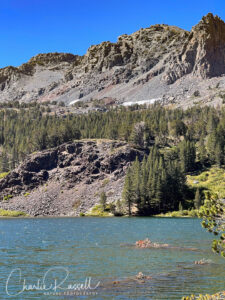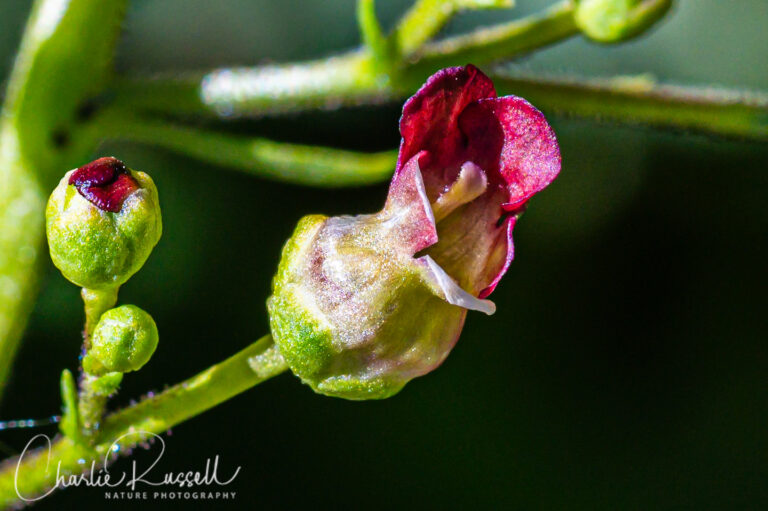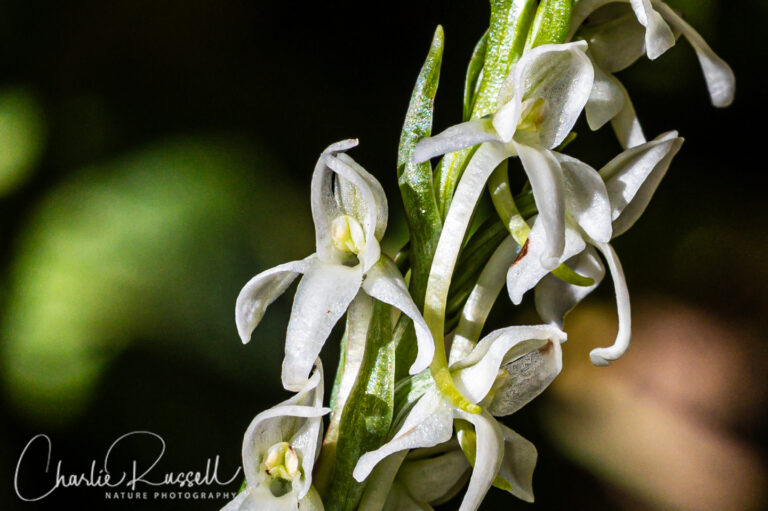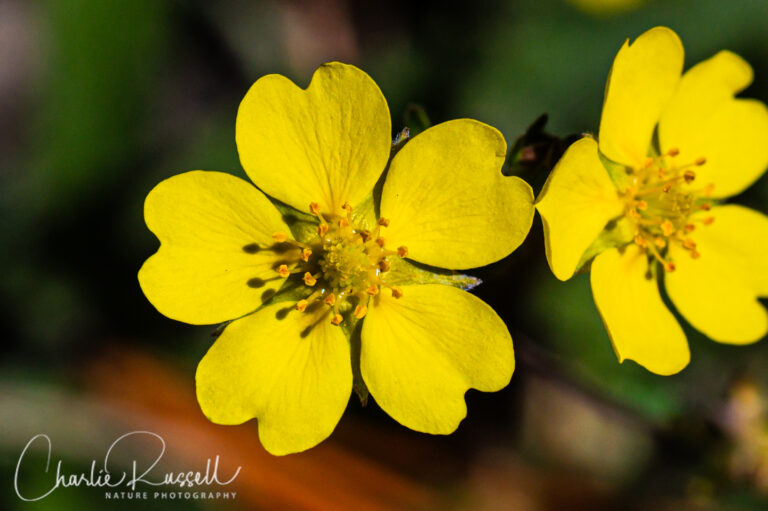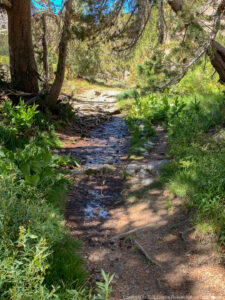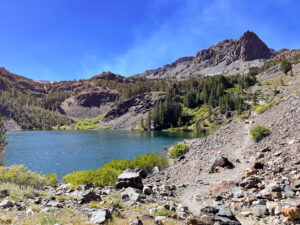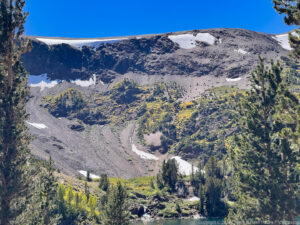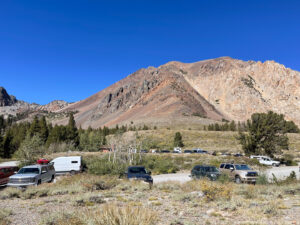The Virginia Lake trail takes you to a series of high-altitude lakes in the Hoover Wilderness area in the Eastern Sierra Nevada, not far from Mono Lake. This is a great place to see a wide variety of wildflowers, and some spectacular scenery.
Note, however, that you are hiking at about 10,000′ elevation with some steep climbs on some parts of the trail, so be prepared!
On our visit we only made it a mile in, just past Blue Lake, before the altitude got to us. I had hoped to make it to Frog Lake, a 3.5 mile round trip with a 500′ elevation gain. For those who are in better shape, you can You can go to Summit Lake, a 9 mile round trip with a 2500′ foot elevation gain.
The Flowers
Here’s a sample of a few of my favorites from this hike (click on the image to see a larger view).
Desert figwort is a small flower but very interesting. This is very similar to the more commonly seen California bee plant (aka California figwort). The lower petals are lighter colored, and this species is found at higher altitudes (It was at about 10,000′). First time I’ve come across this species.
I always get excited when I find a native orchid like this Sierra bog orchid. Note the very long spur at the base of the flower. We found these along the stream coming down from Blue lake.
This late in the season there wasn’t a lot of variety, at least not in the portion of the trail that we were able to cover. Probably the most common wildflower along the way was Slender cinquefoil.
Here are a few of the wildflowers (and insects) that we found on the trail. Since it was late in the season, many of the plants were a bit ragged, so I’m only including the better photos.
For the best viewing experience, click on the lightbox image below, and you can scroll through larger versions of the photos of many of the plants (and other things) that we found on this hike. All photos are available for purchase in a variety of formats.
The Hike
The trail starts at the parking lot by Big Virginia Lake. This is a high altitude hike, starting at 9800′. The trail is well maintained. Unfortunately, we weren’t acclimated to the altitude, so after about a mile in (and facing a fairly steep climb) we had to turn around and head back. I’m hoping that next year we can try again, after a few days of high-altitude hiking/training, and get further in.
This is the second lake, Blue Lake. From here the trail starts to climb. It is very exposed and would be hot in the summer.
We made it up to the trees that you see to the right of center. This is a hillside seep, and we found quite a few wildflowers in that area.
Our goal was to continue up past that knoll that is left of center, to Cooney and Frog Lakes, but the altitude was getting to us so we turned back.
If I visit this area again, earlier in the season, I hope to take a small spur trail that heads south from the parking area to the other side of Big Virginia Lake, heading towards Red Lake. There is a very interesting spot with lots of vegetation and snowmelt that should be a great spot to hunt for wildflowers. This should be easier to reach, since it is at the same level as the parking area.
Here’s the track that we followed:
Virginia Lakes
Profile
Move your mouse along the elevation graph to show the location on the map. The Refresh icon will re-center the map. The Expand icon will expand to full screen.
Directions
From Lee Vining, near Mono Lake, go north on Highway 395 for about 12 miles to the Conway Summit. You are looking for Virginia Lakes Road on the west side. There may be road signs for Virginia Lakes. There is a cluster of buildings on the west of the highway, and a CalTrans facility on the east side.
Follow Virginia Lakes Road, passing the Virginia Lakes Resort, heading to the Virginia Lakes parking area at the end of the road (about 6 miles). This is one of several trailheads in the vicinity, all end up going to the same trail. There is a vault toilet here, and a fairly large parking lot. Note, though, that this is a very popular trailhead, so it may get crowded in the summer.
Timing is Everything
We took a chance with this visit, the end of September in a year where the early cold weather delayed blooming times around Northern California. We lucked out, it was a clear day, not too windy, and temperatures started in the low 60’s. Clearly we were at the end of the bloom, with just a few late season flowers (and a few surprises, like the Sierra bog orchid). Many of the flowers were beat up from the cold weather and rain. This is an area where I would try sometime in late July through August. If you can get up to Frog Lake, or further into the Hoover Wilderness, you should find a very nice variety of sub alpine wildflowers.
Virginia Lakes Wildflowers
Here’s a listing of the native plants that we found on this visit. One of the nice things about hiking in high-altitude areas is that you don’t see a lot of non-native plants!
“nif” means “not in flower”. In most cases the scientific name will be a link to a reference source such as Calflora.
- Arrowleaf ragwort, Senecio triangularis
- Big sagebrush, Artemisia tridentata
- Blue eyed grass, Sisyrinchium sp. (S. bella or S. idahoensis)
- Brewer’s paintbrush, Castilleja applegatei ssp. pallida aka Castilleja applegatei var. breweri
- California corn lily (California false hellebore), Veratrum californicum var. californicum
- California Mugwort, Artemisia douglasiana
- Common Yarrow, Achillea millefolium
- Coulter’s fleabane, Erigeron coulteri
- Cryptantha Owl’s-Clover, Orthocarpus cuspidatus ssp. cryptanthus
- Desert figwort, Scrophularia desertorum
- Dinnerplate thistle, Cirsium scariosum var. americanum
- Drummond’s rockcress, Boechera stricta
- Hoary aster, Dieteria canescens var. canescens
- Jessica stickseed, Hackelia micrantha
- Leichtlin’s mariposa lily, Calochortus leichtlinii
- Mountain coyote mint, Monardella odoratissima ssp. glauca
- Naked buckwheat, Eriogonum nudum
- Northern goldenrod, Solidago multiradiata
- Ocean spray, Holodiscus discolor
- One seeded pussypaws, Calyptridium monospermum
- Owl’s claws, Hymenoxys hoopesii
- Paintbrush, Castilleja sp.
- Poison angelica, Angelica lineariloba (nif)
- Quaking aspen, Populus tremuloides
- Ranger’s buttons, Angelica capitellata
- Rose meadowsweet, Spiraea splendens
- Rubber rabbitbrush. Ericameria nauseosa
- Santa Barbara Sedge, Carex barbarae
- Sierra beardtongue, Penstemon heterodoxus var. heterodoxus
- Sierra bog orchid, Platanthera dilatata var. leucostachys
- Sierra gentian, Gentianopsis holopetala
- Sierran woodbeauty, Drymocallis lactea var. lactea
- Slender cinquefoil (aka Nuttall’s cinquefoil), Potentilla gracilis var. fastigiata
- Sulphur buckwheat, Eriogonum umbellatum
- Swamp onion (Pacific onion), Allium validum
- Wandering fleabane, Erigeron glacialis
- Wax currant, Ribes cereum (in fruit)
- Western blue flag, Iris missouriensis
- Western labrador tea, Rhododendron columbianum (nif)
- Western prickly gooseberry, Ribes montigenum
- Whitebark pine, Pinus albicaulis
- Willow, Salix sp. (nif)
- Wyoming paintbrush, Castilleja linariifolia
- Yellow rabbitbrush, Chrysothamnus viscidiflorus
We also found the following:
- Bandwing grasshopper, Circotettix sp.
- Brook Trout, Salvelinus fontinalis
- Common Aerial Yellowjacket, Dolichovespula arenaria (wasp)
- Common Sickleleg, Asemosyrphus polygrammus (fly)
- Cuckoo bee, tribe Melectini
- Masked bee, Hylaeus sp.
